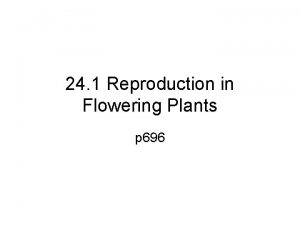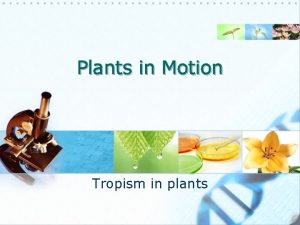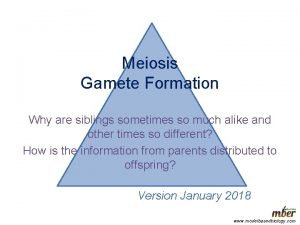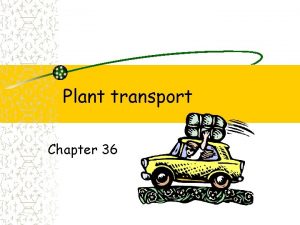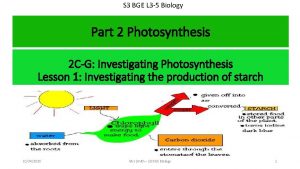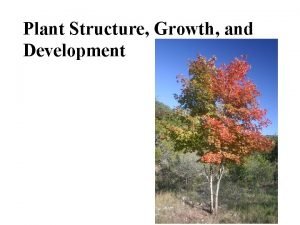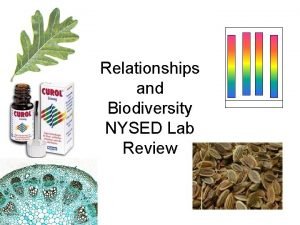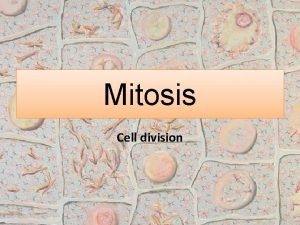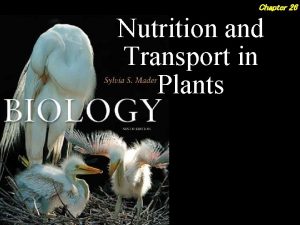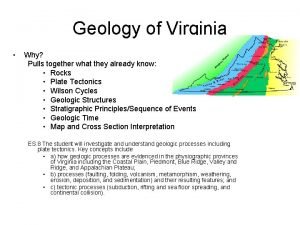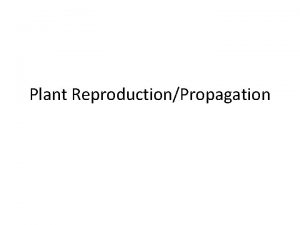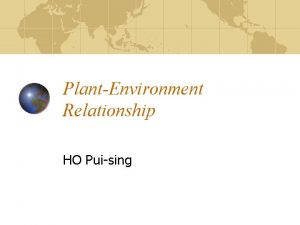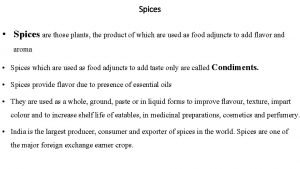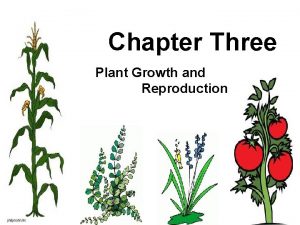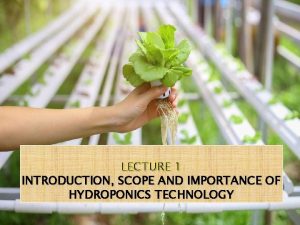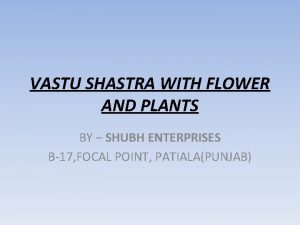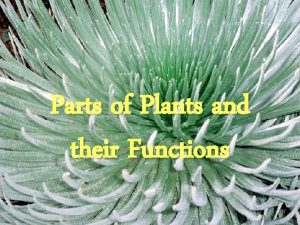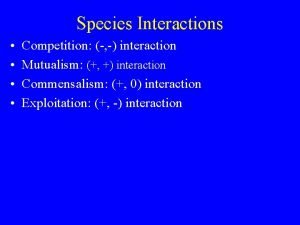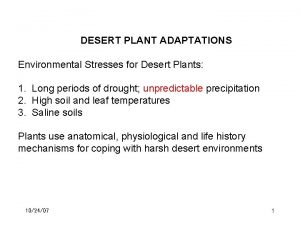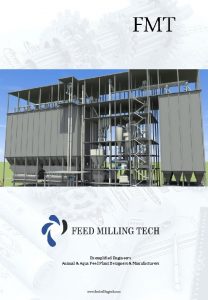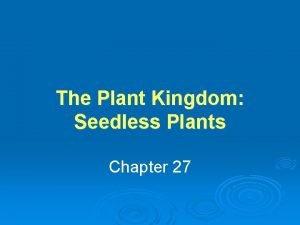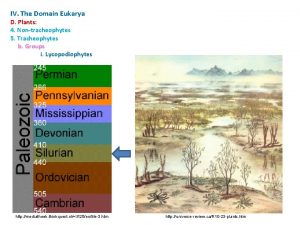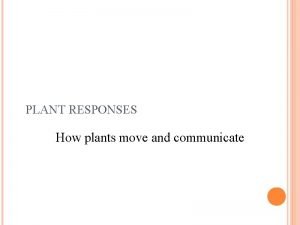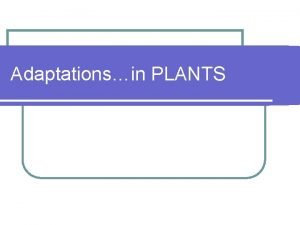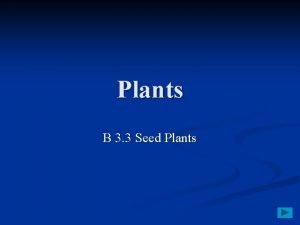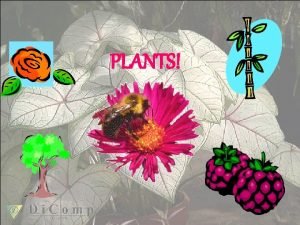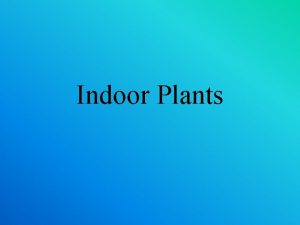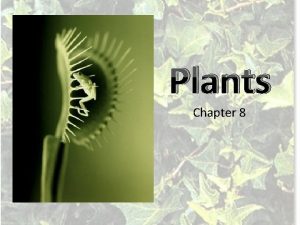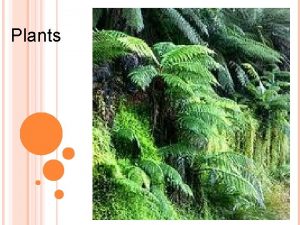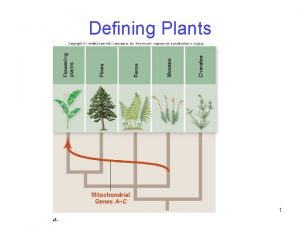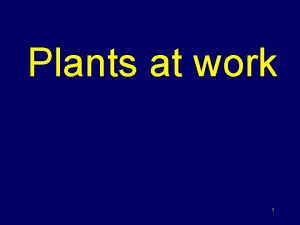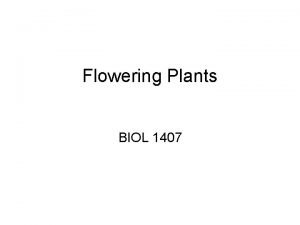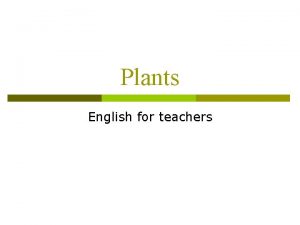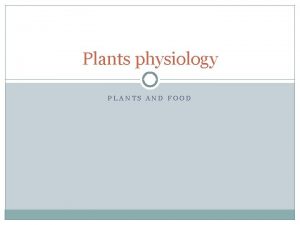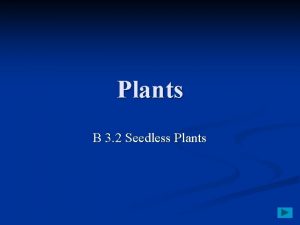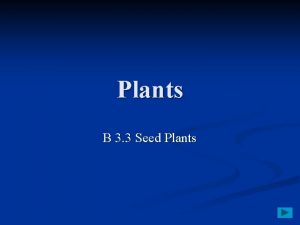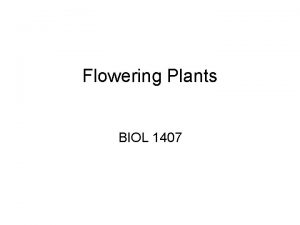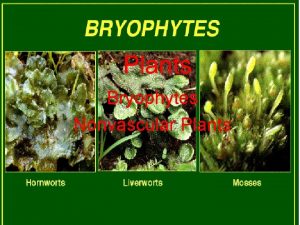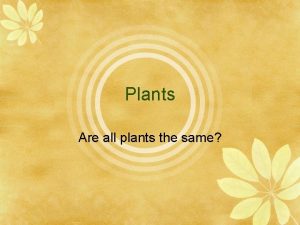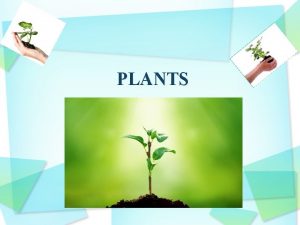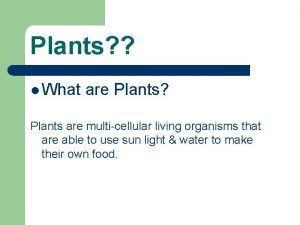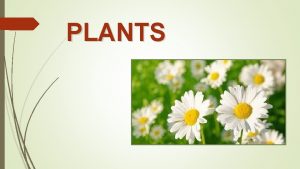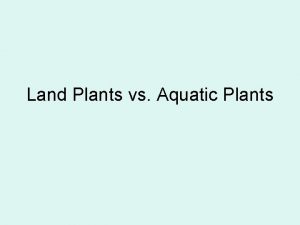Plants 23 1 23 2 23 4 23







































- Slides: 39

Plants 23. 1, 23. 2, 23. 4, 23. 5

Seed Plant Structure • The three principal organs of seed plants are roots, stems, and leaves, as shown in the figure. The organs are linked together by tissue systems that produce, store, and transport nutrients, and provide physical support and protection.

Roots • Roots anchor plants in the ground, holding soil in place and preventing erosion. • Root systems absorb water and dissolved nutrients. • Roots transport these materials to the rest of the plant, store food, and hold plants upright against forces such as wind and rain.

Stems • Plant stems provide a support system for the plant body, a transport system that carries nutrients, and a defensive system that protects the plant against predators and disease.

Stems • Stems also produce leaves and reproductive organs such as flowers. • The stem’s transport system lifts water from the roots up to the leaves and carries the products of photosynthesis from the leaves back down to the roots.

Leaves • Leaves are the plant’s main photosynthetic organs. • Leaves also expose tissue to the dryness of the air and, therefore, have adjustable pores that help conserve water while letting oxygen and carbon dioxide enter and exit the leaf.

Plant Tissue Systems • Plants have three main tissue systems: dermal, vascular, and ground. • These cross sections of the principal organs of seed plants show that all three organs contain dermal tissue, vascular tissue, and ground tissue.

Dermal Tissue • • Dermal tissue is the protective outer covering of a plant. Dermal tissue in young plants consists of a single layer of cells, called the epidermis. The outer surfaces of epidermal cells are often covered with a thick waxy layer called the cuticle, which protects against water loss. In older plants, dermal tissue may be many cell layers deep and may be covered with bark.

Vascular Tissue • • • Vascular tissue supports the plant body and transports water and nutrients throughout the plant. The two kinds of vascular tissue are xylem, a water-conducting tissue, and phloem, a tissue that carries dissolved food. Both xylem and phloem consist of long, slender cells that connect almost like sections of pipe, as shown in the figure.

Ground Tissue • Ground tissue produces and stores sugars, and contributes to physical support of the plant. • Three types of ground tissue, which vary in cell wall thickness, are found in plants: parenchyma (thin cell walls), collenchyma (thicker cell walls), and sclerenchyma (thickest cell walls).

Plant Growth and Meristems • • • Even the oldest trees produce new leaves and new reproductive organs every year, almost as if they remained “forever young. ” The secrets of plant growth are found in meristems. Meristems are regions of unspecialized cells in which mitosis produces new cells that are ready for differentiation. Meristems are found in places where plants grow rapidly, such as the tips of stems and roots.

Apical Meristems • Because the tip of a stem or root is known as its apex, meristems in these regions are called apical meristems. Unspecialized cells produced in apical meristems divide rapidly as stems and roots increase in length. • The micrographs in the figure show examples of stem and root apical meristems.

Apical Meristems • • At first, the new cells that are pushed out of meristems look very much alike: They are unspecialized and have thin cell walls. Gradually, they develop into mature cells with specialized structures and functions. As the cells differentiate, they produce each of the tissue systems of the plant, including dermal, vascular, and ground tissue.

Apical Meristems • • The highly specialized cells found in cones and flowers are also produced in meristems. Flower or cone development begins when the pattern of gene expression changes in a stem’s apical meristem. These changes transform the apical meristem of a flowering plant into a floral meristem. Floral meristems produce the tissues of flowers, which include the plant’s reproductive organs as well as the colorful petals that surround them.

Anatomy of a Root • As seen in the figure, a mature root has an outside layer of dermal tissue, called the epidermis, and also contains vascular tissue and a large area of ground tissue. • The root system plays a key role in water and mineral transport.

Dermal Tissue: Epidermis • The root’s epidermis performs the dual functions of protection and absorption. • Its surface is covered with thin cellular projections called root hairs, which penetrate the spaces between soil particles and produce a large surface area that. allows water and minerals to enter

Ground Tissue • Just inside the epidermis is a region of ground tissue called the cortex. • Water and minerals move through the cortex from the epidermis toward the center of the root. • The cortex also stores the products of photosynthesis, such as starch.

Ground Tissue • A layer of ground tissue known as the endodermis completely encloses the vascular cylinder. • The endodermis plays an essential role in the movement of water and minerals into the center of the root

Vascular Tissue • At the center of the root, the xylem and phloem together make up a region called the vascular cylinder. • Dicot roots like the one shown in the figure have a central column of xylem cells.

Apical Meristem • • • Roots grow in length when apical meristems produce new cells near the root tips. A tough root cap protects the meristem as the root tip forces its way through the soil, secreting a slippery substance that eases the progress of the root through the soil. Cells at the tip of the root cap are constantly being scraped away, and new root cap cells are continually added by the meristem.

Uptake of Plant Nutrients • To grow, flower, and produce seeds, plants require a variety of inorganic nutrients. The nutrients needed in largest amounts are nitrogen, phosphorus, potassium, magnesium, and calcium.

Active Transport of Dissolved Nutrients • • • The cell membranes of root hairs and other cells in the root epidermis contain active transport proteins. Active transport brings the mineral ions of dissolved nutrients from the soil into the plant. The high concentration of mineral ions in the plant cells causes water molecules to move into the plant by osmosis.

Anatomy of a Leaf • • • To collect sunlight, most leaves have a thin, flattened part called a blade. The flat shape of a leaf blade maximizes the amount of light it can absorb. The blade is attached to the stem by a thin stalk called a petiole. Leaves have an outer covering of dermal tissue and inner regions of ground and vascular tissues.

Dermal Tissue • The top and bottom surfaces of a leaf are covered by the epidermis, which has tough, irregularly shaped cells with thick outer walls. • The epidermis of nearly all leaves is covered by a waxy cuticle, a waterproof barrier that protects the leaf and limits water loss through evaporation.

Vascular Tissue • Xylem and phloem tissues are gathered together into bundles called leaf veins that run from the stem throughout the leaf.

Photosynthesis • Beneath the upper epidermis is a layer of cells called the palisade mesophyll, containing closely packed cells that absorb light that enters the leaf. • Beneath the palisade layer is the spongy mesophyll, which has many air spaces between its cells.

Photosynthesis • The air spaces in the spongy mesophyll connect with the exterior through stomata, small openings in the epidermis that allow carbon dioxide, water, and oxygen to diffuse into and out of the leaf.

Transpiration • • The walls of mesophyll cells are kept moist so that gases can enter and leave the cells easily. However, water also evaporates from these surfaces and is lost to the atmosphere. Transpiration is the loss of water through leaves. This lost water may be replaced by water drawn into the leaf through xylem vessels in the vascular tissue.

Transpiration • Transpiration helps to cool leaves on hot days, but it may also threaten the leaf’s survival if water is scarce, as seen in this wilting plant.

Gas Exchange • • • Leaves take in carbon dioxide and give off oxygen during photosynthesis. When plant cells use the food they make, the cells respire, taking in oxygen and giving off carbon dioxide. Plant leaves allow gas exchange between air spaces in the spongy mesophyll and the exterior by opening their stomata.

Homeostasis • If stomata were kept open all the time, water loss due to transpiration would be so great that few plants would be able to take in enough water to survive. • Plants maintain homeostasis by keeping their stomata open just enough to allow photosynthesis to take place but not so much that they lose an excessive amount of water.

Homeostasis • Guard cells, shown in the figure, are highly specialized cells that surround the stomata and control their opening and closing. Guard cells regulate the movement of gases into and out of leaf tissues.

Homeostasis • When water is abundant, it flows into the leaf, raising water pressure in the guard cells, which opens the stomata. • The thin outer walls of the guard cells are forced into a curved shape, which pulls the thick inner walls away from one another, opening the stoma.

Homeostasis • When water is scarce, water pressure within the guard cells decreases, the inner walls pull together, and the stoma closes. This reduces further water loss by limiting transpiration.

Homeostasis • • • In general, stomata are open during the daytime, when photosynthesis is active, and closed at night, when open stomata would only lead to water loss. However, stomata may be closed even in bright sunlight under hot, dry conditions in which water conservation is a matter of life and death. Guard cells respond to conditions in the environment, such as wind and temperature, helping to maintain homeostasis within a leaf.

Transpiration and Wilting • Osmotic pressure keeps a plant’s leaves and stems rigid. • High transpiration rates can lead to wilting. Wilting results from the loss of water—and therefore pressure—in a plant’s cells.

Transpiration • • • As water evaporates through open stomata, the cell walls within the leaf begin to dry out. The dry cell walls draw water from cells deeper inside the leaf’s vascular tissue so that water is pulled up through xylem. The hotter and drier the air, and the windier the day, the greater the amount of water lost and the more water the plant draws up from the roots.

How Cell Walls Pull Water Upward • • Water molecules are attracted to one another by a force called cohesion. Water cohesion is especially strong because of the tendency of water molecules to form hydrogen bonds with each other. Water molecules can also form hydrogen bonds with other substances. This results from a force called adhesion, which is attraction between unlike molecules.

How Cell Walls Pull Water Upward • The tendency of water to rise in a thin tube is called capillary action. Water is attracted to the walls of the tube, and water molecules are attracted to one another. • The thinner the tube, the higher the water will rise inside it, as shown in the figure.
 Reproduce by spores
Reproduce by spores Non vascular plants
Non vascular plants Non flowering plants characteristics
Non flowering plants characteristics C3 plants vs c4 plants
C3 plants vs c4 plants Flower female parts
Flower female parts Chapter 35 plant structure growth and development
Chapter 35 plant structure growth and development Geotropism wikipedia
Geotropism wikipedia How many chromosomes do we have
How many chromosomes do we have Events of fertilization in plants
Events of fertilization in plants How do animals get the nitrogen they need
How do animals get the nitrogen they need Guttation in plants
Guttation in plants Photosynthesis word equation
Photosynthesis word equation Bud function in plants
Bud function in plants Nys biodiversity lab
Nys biodiversity lab Differences between mitosis in plants and animals
Differences between mitosis in plants and animals Guttation in plants
Guttation in plants Devonian plants
Devonian plants Significance of mitosis and meiosis ppt
Significance of mitosis and meiosis ppt Tropophytes plants
Tropophytes plants Spice plants such as coriander
Spice plants such as coriander What makes plants grow
What makes plants grow Importance of hydroponics
Importance of hydroponics Aloe vera vastu
Aloe vera vastu Plants objectives
Plants objectives Nurse plants and seedlings commensalism
Nurse plants and seedlings commensalism Xeromorphic plants
Xeromorphic plants Which months are in spring
Which months are in spring Heterotrophic plants
Heterotrophic plants Plants
Plants The are seedless vascular plants with hollow jointed stems.
The are seedless vascular plants with hollow jointed stems. Detritus food chain
Detritus food chain Survive and protect the endangered plants
Survive and protect the endangered plants Why did mendel prevent his plants from self-pollinating?
Why did mendel prevent his plants from self-pollinating? Respiration in plants
Respiration in plants Latisifer adalah
Latisifer adalah Lycopodiophytes
Lycopodiophytes Plants
Plants Gaseous exchange in protozoa
Gaseous exchange in protozoa Casparian strips
Casparian strips Xerophytes diagram
Xerophytes diagram




